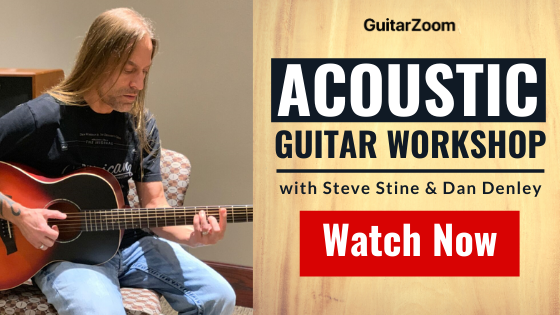Oct 23
How To Play Chords Easier And Faster
In this article, you’ll discover how to play chords more effectively and how to strum more effectively, so you can combine both things and sound awesome when you play songs on your acoustic guitar.
When you’re first starting out, you learn how to make chords like A, G, or others, and sometimes you can strum just one chord and sound great… but when you try to change to a different chord, it’s hard to make your hands and fingers cooperate. :-)
But don’t get discouraged, because ALL guitarists go through this difficult stage. And I've got an easy way to help you sound great when you play chords on your acoustic.
Important question… do you know any guitar chords yet? If you don’t, no worries, just continue reading (and watching).
When you’re first starting out, you learn how to make chords like A, G, or others, and sometimes you can strum just one chord and sound great… but when you try to change to a different chord, it’s hard to make your hands and fingers cooperate. :-)
But don’t get discouraged, because ALL guitarists go through this difficult stage. And I've got an easy way to help you sound great when you play chords on your acoustic.
Important question… do you know any guitar chords yet? If you don’t, no worries, just continue reading (and watching).
Write your awesome label here.
By the end of this article, you’ll know how to both visualize chords and know how to play them more accurately and have smooth transitions from one to another.
Learn How To Visualize Your Chords Before You Actually Play Them
Visualization - creating chords in your head - will help you memorize chords much easier. In fact, you can use this skill to practice guitar chords, even if you don’t have a guitar in your hand.
The first step is to make a list of chords you know how to play, and think about how to place your fingers on the guitar to play that chord. The idea behind this training is to get you ready and remember the chord pattern on your hand. This way you can play chords much faster without having to think about where your hand and fingers go when you’re changing chords on your acoustic guitar.
Example of visualization for D chord:
When you can visualize chords, you will know what to play when you look down on your guitar. Just knowing how to visualize chords helps you play better as well as build confidence.
The first step is to make a list of chords you know how to play, and think about how to place your fingers on the guitar to play that chord. The idea behind this training is to get you ready and remember the chord pattern on your hand. This way you can play chords much faster without having to think about where your hand and fingers go when you’re changing chords on your acoustic guitar.
Example of visualization for D chord:
- The fourth string is open
- Your first finger goes on the third string, second fret
- Your ring finger goes on the second string, third fret
- Your middle finger goes on the at the second fret
When you can visualize chords, you will know what to play when you look down on your guitar. Just knowing how to visualize chords helps you play better as well as build confidence.
A Simple Trick: Make Your Hand “Remember” Chord Shapes
Remember, visualization is key. When you can "see" chords in your head and remember where all your fingers are supposed to go, you're ready to start developing muscle memory for the chord shapes.
Grab your guitar, tune it up, and choose a chord to play. It doesn’t matter which one you start with. Place all your fingers in the correct spots (scroll up to review how to play D, if needed), and press down on the strings. When everything’s ready, strum the strings.
Don’t get discouraged if some strings don’t ring out clearly. Just relax, don’t stress, and adjust your fingers until the chord sounds right. Relax—it’s okay if your fingers don’t immediately know where to go!
Once you’ve got the chord sounding correct when you strum it, lift all your fingers straight up from the fretboard—but hold the chord shape with your fingers. Now, holding that same shape—pretend your fingers are super-glued together in that shape—set your fingers down on the guitar exactly where they were before.
This process helps your fingers learn to quickly find the correct chord shape, and it builds confidence as you practice.
Grab your guitar, tune it up, and choose a chord to play. It doesn’t matter which one you start with. Place all your fingers in the correct spots (scroll up to review how to play D, if needed), and press down on the strings. When everything’s ready, strum the strings.
Don’t get discouraged if some strings don’t ring out clearly. Just relax, don’t stress, and adjust your fingers until the chord sounds right. Relax—it’s okay if your fingers don’t immediately know where to go!
Once you’ve got the chord sounding correct when you strum it, lift all your fingers straight up from the fretboard—but hold the chord shape with your fingers. Now, holding that same shape—pretend your fingers are super-glued together in that shape—set your fingers down on the guitar exactly where they were before.
This process helps your fingers learn to quickly find the correct chord shape, and it builds confidence as you practice.

“Bouncing” Chords To Build Muscle Memory
The purpose of this lesson is not to make you go fast and just be able to play that chord by moving your hand away super fast.
Your goal is whenever you move your hand away from the chord to keep that shape with your fingers, have that pattern in place. The goal is to be able to play that chord without missing the strings and notes… and without having to waste time thinking about where your fingers go. “Bouncing” chords is a great way to build muscle memory. And it works with ANY chord shape. :-)
And if you want to improve your guitar playing even faster, check out All Access Membership.
Your goal is whenever you move your hand away from the chord to keep that shape with your fingers, have that pattern in place. The goal is to be able to play that chord without missing the strings and notes… and without having to waste time thinking about where your fingers go. “Bouncing” chords is a great way to build muscle memory. And it works with ANY chord shape. :-)
And if you want to improve your guitar playing even faster, check out All Access Membership.
Connect with us
Copyright © 2025
Subscribe to our newsletter now!
Get weekly updates on live streams, news and more right in your mailbox.
Thank you!
Login into your account here.
If you forgot your password, click on "Forgot your password?" link below.

